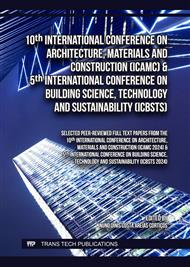p.3
p.13
p.19
p.27
p.33
p.41
p.47
p.55
p.65
Mycelium B-Blocks: Reusable and Adaptable Biodegradable Material for Temporary Structures
Abstract:
One of the ways to advance toward a more regenerative construction industry is by developing a biodegradable, waste-based alternative building material. Building upon the previous research on dry-stacking interlocking modular blocks made of three kinds of organic waste (cotton, coffee chaff, and sawdust+mycelium), this study focuses on designing Mycelium-Based Composite (MBC) B-Blocks. By developing this reusable and adaptable MBC block design, this study addresses the current trend of using MBC solely as a temporary building material. The primary objectives are to refine the B-Blocks module design, improve the proportion to increase configuration possibilities for wall components, and explore different approaches for wall installations using these blocks. The research was conducted with students from the Innovative Digital Technology elective class in the Architecture Department at Universitas Pelita Harapan (UPH). The methodology involved exploring digital tectonics through parametric associative modeling, creating a mock-up model using parametric associative modeling and digital fabrication machinery, and producing 1:1 prototypes of the modules in collaboration with MYCL-Mycotech Lab.
Info:
Periodical:
Pages:
33-39
Citation:
Online since:
January 2025
Price:
Сopyright:
© 2025 Trans Tech Publications Ltd. All Rights Reserved
Share:
Citation:


